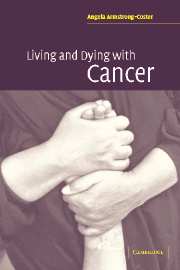1 - Mortality in modern culture
Published online by Cambridge University Press: 22 September 2009
Summary
Dying is not what it used to be. Temporal changes have seen a movement away from a time when dying was often rapid to a time when a lingering trajectory is increasingly becoming the norm (McKeown, 1976; Ariès, 1974; Walter, 1994). We have shifted away from an era when individuals died secure and confident in their unshakeable belief in an after life to an era when dying is perceived to be an inner journey of the psyche (Kubler-Ross, 1995). We have moved away from a period when death was experienced as part of life to a period when fighting death has turned into the meaning of life (Bauman, 1992).
How have social scientists responded to these transformations in the management of dying and death? Lagging behind the exciting and rapidly accelerating developments in technology, only a few psychological and sociological theories or models (Freud, 1959; Gorer, 1965) were in evidence before, even as recently as the late 1960s.
It may be because of the difficulty many find in countenancing their own mortality that, except for work on demographic aspects, social scientific research concerning death was, until the late 1960s, largely focused on the survivors of death, the bereaved, rather than on those who were themselves dying. Death up to this time was presented almost entirely as though the chief protagonist was the mourner and not the individual most concerned: the person who was dying. Death implied bereavement and not dying; it was about those who survived death.
- Type
- Chapter
- Information
- Living and Dying with Cancer , pp. 7 - 15Publisher: Cambridge University PressPrint publication year: 2004



